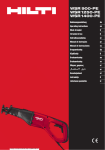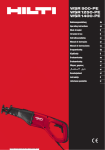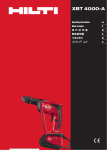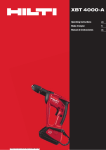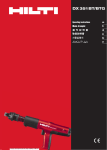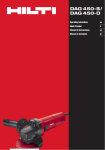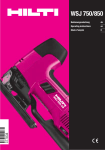Download HILTI WSR1250-PE User's Manual
Transcript
WSR 900 WSR 900-PE WSR 1250-PE WSR 1400-PE 12 Hilti Corporation FL-9494 Schaan Tel.: +423 / 234 2111 Fax: +423 / 234 29 65 www.hilti.com V V V 13 14 V 15 16 *376750* 376750 Hilti = registered trademark of Hilti Corp., Schaan W 2827 0704 5-Pos. 3 1 Printed in Liechtenstein © 2004 Right of technical and programme changes reserved S. E. & O. 376750 / C V Operating instructions en Mode d’emploi fr Manual de instrucciones es 1 1 3 4 2 5 8 9 B min.25mm W SR 90 0PE WS WS WSR 900 6 12 R 12 50 R 14 00 -PE -PE 11 10 9 8 A 7 1 2 3 3 4 10 5 WS R 900 -PE min.40mm WSR 900-PE 1250- PE WSR 1400-PE WSR 6 E 0-P R 140 WS WSR 1400-P 12 E 11 10 9 8 1 2 4 4 7 min.40mm -P WS R 14 00 5 WSR 1250-PE E WSR 1400-P E min.40mm WSR 900 / WSR 900-PE WSR 1400-PE 12 11 10 9 8 1 7 This product is UL listed and CSA certified to US and Canadien safety standards Ce produit est homologué UL et certifié CSA (conforme aux normes de sécurité américaines et candiennes) Producto homologado según normas de seguridad americanas y canadienses Produto homologado de accordo com as normas de segurança americanas e canadianas 6 2 3 4 5 C US C R US WSR1250-PE / WSR1400-PE WSR 1400-PE UL listed to US and Canadien safety standards Homologué UL (conforme aux normes de sécurité américaines et candiennes) Producto homologado según normas de seguridad americanas y canadienses Produto homologado de accordo com as normas de segurança americanas e canadianas 12 11 10 9 8 7 6 C R US 5 6 7 11 1– 6 2 3 WSR 900 / WSR 900-PE / WSR1250-PE / WSR1400-PE reciprocating saw It is essential that the operating instructions are read before the tool is operated for the first time. 1. General information en 1.1 Signal words and their meaning Always keep these operating instructions together with the tool. -WARNINGThe word WARNING is used to draw attention to a potentially dangerous situation which could lead to severe personal injury or death. Ensure that the operating instructions are with the tool when it is given to other persons. -CAUTIONUsed to draw attention to a potentially dangerous situation which could lead to minor personal injury or damage to the equipment or other property. -NOTEUsed to draw attention to an instruction or other useful information. 1.2 Pictograms Operating controls and parts Blade clamp / blade holder Orbital action selector switch (only WSR 900-PE / WSR 1250-PE / WSR 1400-PE) Stroke rate regulator (only WSR 900 / WSR 900-PE / WSR 1400-PE) Transport lock Control switch Type plate Motor Gearing section Front-end grip area (hand guard) Lockbutton for adjusting the contact shoe Contact shoe Saw blade (insert tool) Contents 1. General information 2. General safety rules 3. Specific safety rules and symbols 4. Functional description 5. Assembly 6. Operation 7. Care and maintenance 8. Blades and accessories 9. Troubleshooting 10. Disposal 11. Warranty Page 1 2 3 5 6 7 8 8 9 9 10 Warning signs General warning Warning: electricity Warning: hot surface Obligation signs Wear eye protection Wear ear protection Symbols Wear protective gloves Wear breathing protection Read the operating instructions before use. These numbers refer to the corresponding illustrations. The illustrations can be found on the fold-out cover pages. Keep these pages open while studying the operating instructions. In these operating instructions, the WSR 900 / WSR 900PE / WSR 1250-PE / WSR 1400-PE reciprocating saw is referred to as "the tool". Location of identification data on the tool The type designation and serial number can be found on the rating plate on the tool. Make a note of this data in your operating instructions and always refer to it when making an enquiry to your Hilti representative or service department. Type: Serial no.: 1 2. General safety rules en 1. WARNING! Read and understand all instructions. Failure to follow all instructions listed below may result in electric shock, fire and/or serious personal injury. SAVE THESE INSTRUCTIONS 2. Work Area Keep your work area clean and well lit. Cluttered benches and dark areas invite accidents. Do not operate power tools in explosive atmospheres, such as in the presence of flammable liquids, gases, or dust. Power tools create sparks which may ignite the dust or fumes. Keep bystanders, children and visitors away while operating a power tool. Distractions can cause you to lose control. 3. Electrical Safety Double Insulated tools are equipped with a polarized plug (one blade is wider than the other.) This plug will fit in a polarized outlet only one way. If the plug does not fit fully in the outlet, reverse the plug. If it still does not fit, contact a qualified electrician to install a polarized outlet. Do not change the plug in any way. Double Insulation Z eliminates the need for the three wire grounded power cord and grounded power supply system. Applicable only to Class II tools. Avoid body contact with grounded surfaces such as pipes, radiators, ranges and refrigerators. There is an increased risk of electric shock if your body is grounded. Don’t expose power tools to rain or wet conditions. Water entering a power tool will increase the risk of electric shock. Do not abuse the cord. Never use the cord to carry the tools or pull the plug from an outlet. Keep cord away from heat, oil, sharp edges or moving parts. Replace damaged cords immediately. Damaged cords increase the risk of electric shock. When operating a power tool outside, use an outdoor extension cord marked «W-A» or «W». These cords are rated for outdoor use and reduce the risk of electric shock. 4. Personal Safety Stay alert, watch what you are doing and use common sense when operating a power tool. Do not use a tool while tired or under the influence of drugs, alcohol, or medication. A moment of inattention while operating power tools may result in serious personal injury. Dress properly. Do not wear loose clothing or jewelry. Contain long hair. Keep your hair, cloth2 ing, and gloves away from moving parts. Loose clothes, jewelry, or long hair can be caught in moving parts. Avoid accidental starting. Be sure switch is off before plugging in. Carrying tools with your finger on the switch or plugging in tools that have the switch on invites accidents. Remove adjusting keys or wrenches before turning the tool on. A wrench or a key that is left attached to a rotating part of the tool may result in personal injury. Do not overreach. Keep proper footing and balance at all times. Proper footing and balance enables better control of the tool in unexpected situations. Use safety equipment. Always wear eye protection. Dust mask, non-skid safety shoes, hard hat or hearing protection must be used for appropriate conditions. 5. Tool Use and Care Use clamps or other practical way to secure and support the workpiece to a stable platform. Holding the work by hand or against your body is unstable and may lead to loss of control. Do not force tool. Use the correct tool for your application. The correct tool will do the job better and safer at the rate for which it is designed. Do not use tool if the switch does not turn it on or off. Any tool that cannot be controlled with the switch is dangerous and must be repaired. Disconnect the plug from the power source before making any adjustments, changing accessories, or storing the tool. Such preventive safety measures reduce the risk of starting the tool accidentally. Store idle tools out of reach of children and other untrained persons. Tools are dangerous in the hands of untrained users. Maintain tools with care. Keep cutting tools sharp and clean. Properly maintained tools with sharp cutting edges are less likely to bind and are easier to control. Check for misalignment or binding of moving parts, breakage of parts and any other condition that may affect the tools operation. If damaged, have the tool serviced before using. Many accidents are caused by poorly maintained tools. Use only accessories that are recommended by the manufacturer for your model. Accessories that may be suitable for one tool may become hazardous when used on another tool. 6. Service Tool service must be performed only by qualified repair personnel. Service or maintenance performed by unqualified personnel could result in a risk of injury. When servicing a tool, use only identical replacement parts. Follow instructions in the Maintenance section of this manual. Use of unauthorized parts or failure to follow Maintenance Instructions may create a risk of electric shock or injury. en 3. Specific safety rules and symbols 3.1 Basic information concerning safety In addition to the information relevant to safety given in each of the sections of these operating instructions, the following points must be strictly observed at all times. -WARNINGRead all safety precautions and instructions! Failure to observe the following safety precautions and instructions may lead to electric shock, fire and/or serious injury. 3.2 Take the necessary precautions to make the workplace safe Ensure that the workplace is well ventilated. Keep the working area tidy. Objects which could cause injury should be removed from the working area. Untidiness at the workplace may lead to accidents. ● Keep the area above and below the cutting line free of obstacles. ● Wear suitable working clothing. Wear a hair net if you have long hair. ● Do not permit other persons to touch the electric tool or the extension cord. ● Avoid unusual body positions. Work from a secure stance and stay in balance at all times. ● To avoid tripping and falling when working, always lead the supply cord and extension cord away to the rear. ● Concealed electric cables or gas and water pipes present a serious hazard if damaged while you are working. Accordingly, check the area in which you are working beforehand (e.g. using a metal detector). ● Unknown base materials should be examined in order to avoid personal injury or the possibility of cutting into pipes or cables. Use the right blade for the material being cut. ● Do not cut unless there is proper clearance beyond the workpiece being cut. The blade may cause the tool to kick-back if it strikes a hidden object. ● Before cutting pipes, always first ensure that the pipes contain no liquids. Empty the pipes if necessary. The tool is not water or moisture proof. Liquids running out may cause a short circuit in the tool resulting in an electric shock being received. When cutting pipes, hold the tool so that it is higher than the pipe being cut. ● ● 3.3 General safety precautions To ensure efficient and safe operation, the contact shoe of the tool must be pressed against the workpiece . ● Keep the tool, especially its grip surfaces, clean and free from oil and grease. ● Always hold the tool securely, with both hands on the grips provided . Make sure to grip the tool and position your hands and fingers so they will not contact or slip into the area of the blade clamp or saw blade. ● Switch on the tool only after it has been brought into position where the cut is to be made. ● Do not start the tool with the blade contacting the work surface. ● When cutting, always guide the tool away from the body. ● Switch the tool off before transporting it. ● Always allow the tool to come to a complete stop before removing it from the workpiece. ● Never place your hands in front of or on the saw blade. ● Check the tool for possible damage. Protective devices and any parts that may have suffered slight damage should be checked for correct operation and functionality before further use of the electric tool. Safety devices or other parts that are found to be damaged must be replaced or repaired properly by an authorized repair workshop unless otherwise indicated in the operating instructions. ● Always use saw blades of adequate length. To help avoid kick-back while sawing, the blade must always project at least 40 mm (1.5 in) beyond the workpiece during the stroke cycle . ● 3.3.1 Mechanical ● Ensure that the saw blades used are equipped with the correct connection end system and that they are properly fitted and secured in the blade clamp. 3 3.3.2 Electrical en Protect yourself against electric shock. Avoid body contact with earthed / grounded objects, e.g. pipes and radiators etc. ● Check the condition of the tool’s supply cord at regular intervals. The supply cord should be replaced by a trained electrical specialist if damage is found. Also regularly check the condition of extension cords and replace these if damage is found. ● Do not touch the supply cord in the event of it suffering damage while working. Disconnect the supply cord plug from the power supply. ● The tool should be repaired only by a trained electrical specialist (Hilti service centre) using original Hilti spare parts. Failure to observe this point my result in a risk of accident to the user. ● Do not use the supply cord for purposes for which it is not intended. ● Never carry the tool by the power supply cord. ● Do not pull the plug out of the socket by pulling the supply cord. ● Do not expose the supply cord to heat, oil or sharp edges. ● When working outdoors, use only extension cords approved and correspondingly marked as suitable for outdoor use. ● Avoid using extension cords with multiple sockets and the simultaneous use of several electric tools connected to one extension cord. ● Never operate the tool when it is dirty or wet. Dust or dampness on the surface of the tool make it difficult to hold and, under unfavorable conditions, may lead to electric shocks. Accordingly, have the tool checked regularly at a Hilti service center if it is used frequently for cutting conductive materials. ● Hold tool by insulated gripping surfaces when performing an operation where the cutting tool may contact hidden wiring or its own cord. Contact with a “live” wire will make exposed metal parts of the tool “live” and shock the operator. ● 3.3.3 Thermal ● 4 The saw blade may become hot during use. You should therefore wear protective gloves when changing saw blades. When using the pipe cutting adaptor (accessory), especially when cutting large-diameter pipes, apply only moderate pressure and select a suitable cutting speed in order to avoid overheating the tool. ● The cutting produced when sawing, especially metal cuttings, may be hot. Wear suitable protective clothing. ● 3.3.4 Dust Wear respiratory protection when the work causes dust. ● Before beginning work, find out the hazard class of the dust produced by the work. Use only an industrial vacuum cleaner with an officially approved protection classification in compliance with your local dust control regulations for work with the tool. ● Proposition 65 warning: This product contains or produces an exposure to chemicals known to the State of California to cause cancer and birth defects (or other reproductive harm). ● 3.4 Requirements to be met by users The tool is intended for professional use. The tool may be operated, serviced and repaired only by authorized, trained personnel. This personnel must be informed of any special hazards that may be encountered. ● Take breaks between working and do exercises your fingers to relax the muscles and improve the blood circulation in your fingers. ● ● 3.5 Personal protective equipment The user and any other persons in the vicinity must wear suitable eye protection. Ear protection and protective gloves should be worn as conditions warrant. They must also wear breathing protection if no dust removal system is used. Wear eye protection Wear ear protection Wear protective gloves Wear breathing protection 3.6 Protective devices Never use the tool without the hand guard fitted. Symbols used on the tool: V volts ~ alternating current Hz hertz A amperes n0 no load speed /min revolutions per minute ∅ diameter Z double insulated 4. Functional description 4.1 Use of the WSR 900 / WSR 900-PE as directed Typical working environments include rescue services, public authorities, farming and forestry, general construction, renovation and conversion work, metal construction, plumbing / heating / air-conditioning installation trades, in workshops and on construction sites. ● The tool may be used for cutting wood, wood-like materials, metals and plastics. ● The tool must be used in a dry environment. ● The tool may be powered only by an electric supply voltage in compliance with the information given on the type plate. ● The tool is designed for two-handed operation. ● Use only the blades and accessories listed in the operating instructions. ● lation trades, rescue services, public authorities, farming and forestry, in workshops and on construction sites. ● The tool may be used for cutting wood, wood-like materials, metals, plastics, bricks, cellular concrete and tiles. ● The tool must be used in a dry environment. ● The tool may be powered only by an electric supply voltage in compliance with the information given on the type plate. ● The tool is designed for two-handed operation. ● Use only the blades and accessories listed in the operating instructions. Do not use the tool to cut concrete or natural stone. Use the tool within its intended cutting performance range and with suitable blades (do not use blades of the wrong size or reciprocating saw blades not equipped with a 1/2" connection end). ● Cutting materials containing asbestos is not permissible. ● ● Do not use the tool to cut bricks, concrete, cellular concrete, natural stone or tiles. ● Use the tool within its intended cutting performance range and with suitable blades (do not use blades of the wrong size or reciprocating saw blades not equipped with a 1/2" connection end). ● Cutting materials containing asbestos is not permissible. ● 4.2 Use of the WSR 1250-PE / WSR 1400-PE as directed ● Typical working environments include general construction, renovation and conversion work, metal construction, plumbing / heating / air-conditioning instal- 4.3 The items supplied include: – Reciprocating saw and saw blade – Operating instructions – Toolbox See figure and the explanations of operating controls and components on page 1. Technical data Tool WSR 900 Nominal power rating 900 W Nominal voltage 120 V / 8.5 A Nominal current input Mains frequency 50 / 60 Hz Weight of tool 6.28 lbs (2.85 kg) Dimensions 17.4×3.5×8.3 in (L×B×H) (442×88×211 mm) Stroke rate 0–2700 min–1 Stroke 11/4 in (32 mm) WSR 900-PE WSR 1250-PE WSR 1400-PE 900 W 1250 W 1400 W 120 V / 8.5 A 120 V / 12 A 120 V / 13 A 50 / 60 Hz 7.2 lbs (3.26 kg) 17.4×3.5×8.3 in (442×88×211 mm) 0–2700 min–1 11/4 in (32 mm) 50 / 60 Hz 9.3 lbs (4.2 kg) 19.4×4 ×7.1 in (493×101×180 mm) 0–2700 min–1 11/4 in (32 mm) 50 / 60 Hz 9.9 lbs (4.5 kg) 22.6×4×7.4 in (574×101×188 mm) 0–2700 min–1 11/4 in (32 mm) 5 en Stroke rate regulation en Constant-speed electronics with variable stroke rate, stroke rate regulator with 6 pos. Blade clamp Orbital action Double insulated Constant-speed elec- Constant-speed elec- Constant-speed electronics with variable tronics with variable tronics with variable stroke rate, stroke rate stroke rate stroke rate, stroke rate regulator with 6 pos. regulator with 6 pos. Keyless, for standard 1/2″ blades on / off (only WSR 900-PE / WSR 1250-PE / WSR 1400-PE) Protection class II (double insulated) Z Right of technical changes reserved 5. Assembly 3. Pull the blade out of the clamp toward the front of the tool. 4. Release the locking sleeve. -NOTEThe electric supply voltage must comply with the information on the type plate. -CAUTION● ● ● ● The cutting edges of the saw blade are sharp. The cutting edges may present a risk of injury. Moving parts may present a risk of injury. Wear protective gloves. If extension cords are used: Use only extension cords of a type approved for the intended purpose and of adequate cross section. Failure to observe this point may result in reduced performance and may cause the cord to overheat. Replace damaged extension cords. Use only correspondingly marked and approved extension cords for working outdoors. Recommended minimum cross sections and max. cord lengths: Mains voltage 110–120 V 230 V Conductor cross section 1.5 mm2 2.5 mm2 20 m 40 m 50 m 100 m AWG 14 75 ft – 12 125 ft – 5.1 Fitting the saw blade 1. Unplug the supply cord from the electric socket. 2. Check that the connection end of the blade is clean. The blade clamp should also be kept clean. Use only saw blades with 1/2″ connection ends . 3. Turn the blade clamp locking sleeve in a counterclockwise direction and hold it in this position. 4. Push the saw blade into the blade clamp. 5. Release the locking sleeve and allow it to move back. It should be heard to engage. 6. Check that the clamp has engaged by pulling on the blade. 5.2 Removing the saw blade 1. Unplug the supply cord from the electric socket. 2. Turn the blade clamp locking sleeve in a counterclockwise direction and hold it in this position. 6 5.3 Adjusting the contact shoe The contact shoe can be adjusted to provide optimum use of the blade length and to improve access in corners. 1. Unplug the supply cord from the electric socket. 2. Remove the saw blade (see 5.2). 3. Press the contact shoe lockbutton and hold it in this position. 4. Slide the contact shoe forward or back into the desired position. 5. Release the lockbutton. 6. Pull on the contact shoe to check that it has engaged. 5.4 Using the pipe cutting adaptor (accessory) 1. Unplug the supply cord from the electric socket. 2. Remove the saw blade (see 5.2). 3. Press the contact shoe lockbutton and hold it in this position. 4. Pull the contact shoe away from the tool toward the front. 5. Push the pipe cutting adaptor into the tool from the front until it is in the desired position. 6. Release the lockbutton. 7. Pull on the pipe cutting adaptor to check that it has engaged. 8. Open the screw clamp to the maximum position. 9. Place the adapter chain around the pipe, locking the chain to the fitting. -NOTE- The handle should be at a 45° angle. 5.5 Fitting the side handle (accessory) 1. Unplug the supply cord from the electric socket. 2. Remove the saw blade (see 5.2). 3. Place the adaptor around the front grip section from above and close the adaptor. 4. Slide the side handle onto the adaptor from the front. 5. Secure the side handle by turning the screw knob on the handle. 5.6 Positioning the side handle (accessory) 1. Unplug the supply cord from the electric socket. 2. Slacken the screw knob on the side handle. 3. Bring the side handle into the desired position. 4. Secure the side handle by turning the screw knob on the handle. 6. Operation 6.1 Switching on/off 1. Plug the supply cord into the electric socket. 2. Press the transport lock and then press the control switch. -CAUTION● ● ● The cutting edges of the saw blade are sharp. The cutting edges may present a risk of injury. Wear protective gloves. -WARNING- ● ● ● The sawing operation swirls up dust and wood chips into the air. The dust and wood chips may be harmful to the eyes and respiratory system. Wear protective goggles and breathing protection. -WARNING- ● ● ● Operation of the tool creates noise. Excessive noise may damage the hearing. Wear ear protection. -NOTE● To ensure good cutting performance and ease the load on the tool, use only saw blades that are in good condition. ● Do not overload the tool. -WARNING● When working, always guide the tool away from the body. ● Lift the tool away from the workpiece only once the blade has come to a standstill. ● Do not lay the tool down before the blade has come to a standstill. -CAUTION● ● ● The saw blade becomes hot when used for long periods. There is a risk of burning if the blade is touched. Wear protective gloves. 6.2 Stroke rate 6.2.1 Adjusting the stroke rate The recommended stroke rate can be selected by turning the stroke rate regulator. When the control switch is pressed the tool will then run up to the pre-selected speed. The electronic speed control system maintains constant stroke rate even under load. The recommended stroke rate settings and information concerning the correct choice of saw blade can be found in the product information and in the corresponding table of applications. 6.2.2 Recommended stroke rates (1 = low stroke rate, 6 = high stroke rate) Material to be cut Wood Wood with embedded nails Interior finishing, drywall Plastic Steel Non-ferrous metals Aluminum Stainless steel Recommended stroke rate 5–6 5–6 3–4 3–4 2–3 2–3 2–3 1 The above settings are general guidelines intended to provide optimum cutting performance. These also apply when the pipe cutting adapter (accessory) is used. The optimum setting may differ from these recommendations depending on the saw blade used, the electric supply voltage and on how the tool is used. Setting the wrong stroke rate may cause the saw blade to wear more quickly, and could damage the tool. 6.3 Orbital action (only WSR 900-PE / WSR 1250-PE / WSR 1400-PE) Use of the orbital action can increase cutting performance in certain soft materials such as wood materials. The orbital action can be switched on or off by moving the orbital action selector switch as far as it will go in each position. Move the switch only when the motor has stopped. 6.3.1 Orbital action off Orbital action off 6.3.2 Orbital action on Orbital action on 7 en en 6.4 Plunge sawing The plunge sawing technique should be used only on soft materials and when the orbital action is switched off. A little practice is required in order to be able to plunge the blade into the material while the tool is running and thus make cut-outs without first drilling a hole. Plunge sawing is possible only with short saw blades. Plunge cuts may be started with the tool in one of two different positions: – in the normal position – or in the reversed position 1. Hold the tool with the front edge of the contact shoe against the workpiece. 2. Press the transport lock and then press the control switch. 3. Press the tool firmly against the workpiece and begin the plunge movement by reducing the angle of the tool (contact shoe) to the workpiece. It is important to ensure that the tool is running before the blade is brought into contact with the workpiece. The tool may otherwise stall or kick-back. 4. Once the blade has passed through the workpiece, bring the tool into the normal working position (the entire surface of the shoe in contact) and then continue sawing along the line. 7. Care and maintenance Unplug the supply cord from the mains socket. 7.1 Care of blades Clean off dirt and dust deposits and protect your blades from corrosion by wiping them from time to time with an oil-soaked rag. 7.2 Care of the tool Keep the blade clamp clean. The tool was lubricated adequately when it was manufactured. After long periods of heavy use it is recommended that the tool is inspected at a Hilti repair center. This will increase the life expectancy of the tool and avoid unnecessary repair costs. ● Repairs to the electrical section of the tool may be carried out only by a trained electrical specialist. brush. Do not permit foreign objects to enter the interior of the tool. Clean the outside of the tool at regular intervals using a slightly damp cloth. Do not use a spray, steam pressure cleaning equipment or running water for cleaning. This may negatively affect the electrical safety of the tool. Always keep the grip surfaces of the tool free from oil and grease. Do not use cleaning agents which contain silicone. ● ● 7.3 Maintenance Check all external parts of the tool for damage at regular intervals and check that all controls operate faultlessly. Do not operate the tool if parts are damaged or when the controls do not function faultlessly. If necessary, your electric tool should be repaired at a Hilti repair center. Repairs to the electrical section of the tool may be carried out only by trained electrical specialists. The outer casing of the tool is made from impact-resistant plastic. Sections of the grip are made from an elastomer material. Never operate the tool when the ventilation slots are blocked. Clean the ventilation slots carefully using a dry 7.4 Checks after care and maintenance After care and maintenance, check that the hand guard and contact shoe are fitted and that they function faultlessly. 8. Blades and accessories Saw blades Pipe cutting adaptor Side handle / Side handle adaptor 8 9. Troubleshooting Fault The tool doesn't start. The tool does not achieve full power. No orbital action (only WSR 900-PE / WSR 1250 PE / WSR 1400-PE). Saw blade cannot be removed from the blade clamp. Contact shoe or pipe clamp cannot be removed frome the tool. Possible cause Fault in mains supply. Remedy Plug in another electric appliance and check whether it works. Supply cord or plug defective. The cord should be checked and, if necessary, replaced by an electrical specialist. Control switch defective. The switch should be checked and, if necessary, replaced by an electrical specialist. Extension cord with inadequate cross Use an extension cord with adequate cross section used. section. (See "Assembly".) Low stroke rate selected. Set the stroke rate regulator to the setting recommended for the material to be cut (see section "Assembly"). Control switch not pressed fully. Press the control switch as far as it will go. Orbital action selector switch not Set the orbital action selector switch to ]. [ ]. The orbital action can be felt only set to [ when sawing. Locking sleeve not turned as far as it will go. Turn the locking sleeve as far as it will go and remove the saw blade. Obstructed by blade. Remove the saw blade (see 5.2) and then remove the contact shoe. Press the lockbutton fully and remove the blade. Lockbutton is not fully pressed. 10. Disposal Most of the materials from which Hilti electric tools are manufactured can be recycled. The materials must be correctly separated before they can be recycled. In many countries, Hilti has already made arrangements for taking back your old electric tools for recycling. Please ask your Hilti customer service department or Hilti representative for further information. Should you wish to return the electric tool yourself to a disposal facility for recycling, proceed as follows: Dismantle the electric tool as far as possible without the need for special tools. Use absorbent paper to wipe oily parts clean and to collect any grease that runs out (total quantity approx. 50 ml). This paper should also be disposed of correctly. On no account should oil or grease be allowed to enter the waste water system or to find its way into the ground. The individual parts should be separated as follows: Part / assembly Toolbox Gear housing Grip Motor housing Grip cover Fan Motor (rotor and stator) Supply cord Gearing parts Screws, small parts Main material Plastic Aluminium Plastic Plastic Plastic Plastic Steel and copper Copper, elastomer Steel Steel Recycling Plastics recycling Scrap metal Plastics recycling Plastics recycling Plastics recycling Plastics recycling Scrap metal Scrap metal Scrap metal Scrap metal 9 en 11. Warranty en Hilti warrants that the tool supplied is free of defects in material and workmanship. This warranty is valid so long as the tool is operated and handled correctly, cleaned and serviced properly and in accordance with the Hilti Operating Instructions, all warranty claims are made within 12 months from the date of the sale (invoice date), and the technical system is maintained. This means that only original Hilti consumables, components and spare parts may be used in the tool. This warranty provides the free-of-charge repair or replacement of defective parts only. Parts requiring repair or replacement as a result of normal wear and tear are not covered by this warranty. Under no circumstances will Hilti be obligated for direct, indirect, incidental or consequential dam- 10 ages, losses or expenses in connection with, or by reason of, the use of, or inability to use the tool for any purpose. Hilti specifically excludes the implied warranties of merchantability and fitness for a particular purpose. For repair or replacement, send tool and/or related parts immediately upon discovery of the defect to the address of the local Hilti marketing organization provided. This constitutes Hilti’s entire obligation with regard to warranty and supersedes all prior or contemporaneous comments and oral or written agreements concerning warranties.













